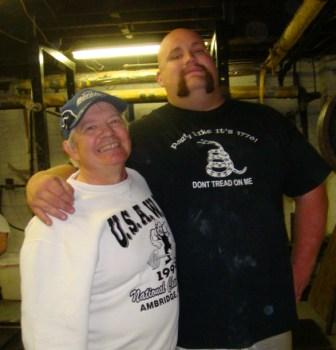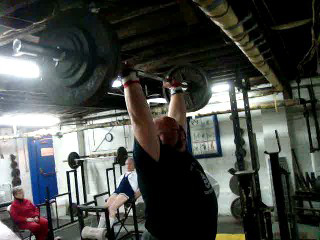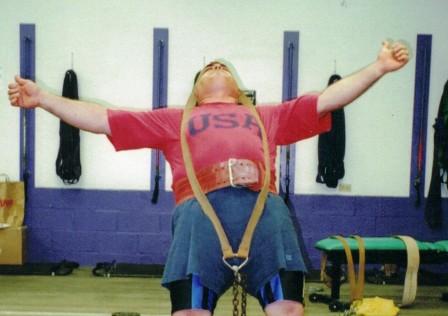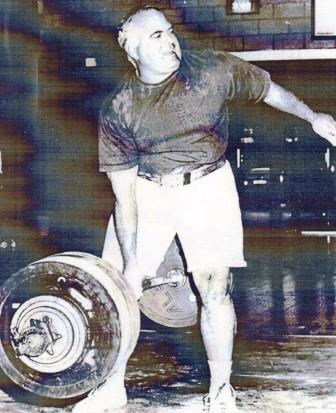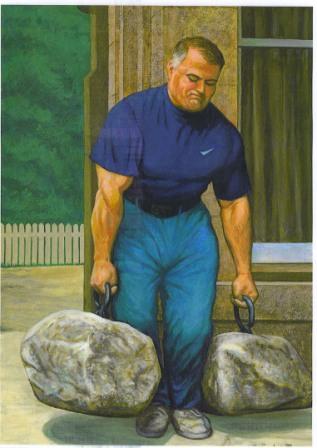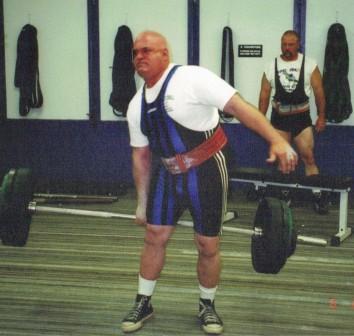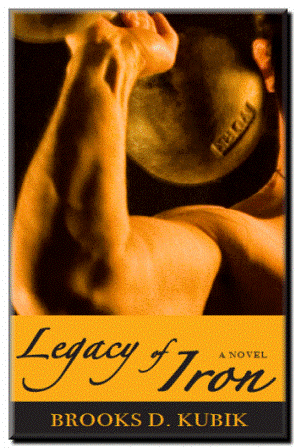WHERE’S THE BEEF? At Future USAWA meets!
by John McKean
His online handle is “Beef” and at 6’2″ and 390 pounds, big Ernie Beath sure fits the billing! The polite and pleasant 28-year-old strongman from Cambridge, Maryland, and I started e-mailing sometime back, and I was simply astounded over his reported training poundages. It was only natural that the pressing variations he favors be verified for the world by doing them in sanctioned USAWA events, and he was most anxious to acquire official verification. So Ernie traveled over to Ambridge for Art’s annual Birthday Bash Record Day, and wasted no time doing a perfect world record rack push press with 381 pounds. It was so easy that we talked him into a 401 pound attempt, which was almost locked out, perhaps simply a victim of first meet jitters! But he’ll try over 400 at our December 6 meet (We’d like a big turnout guys!!! Come on over!) and will take a shot at a huge JERK from the rack, where’s his gym best is over 450!!
Ernie is a home trainee, and has developed his training concepts almost entirely on his own. He found out early on that he could make best strength gains with heavy singles, so goes almost to top limits on a variety of lifts (2 or 3 per session, 4 times per week on average) every workout. He really enjoys pushing big weights overhead, doing things like the above mentioned presses & jerks from the rack, clean & press behind the neck, and even strict presses while seated flat on the floor. However, he’s not too keen on flat benches or lying down to lift, ever since a training accident with 700 pounds in the partial close grip bench press cost him an eye (after the hospitalization, he bounced right back to the heavy lifting that means so much to him!).
A true all-rounder, Ernie has always done “variations” from standard lifts, even without knowing about us in the USAWA, such as Zerchers, squats with the bar held overhead in snatch position, various close stance deadlift forms, and high pulls/continental types. An unusual move that both Ernie and I are trying to get established as an official IAWA lift is the bent over row in both strict and “power” forms. The Beefster hauls in over 500 pounds in this back strengthening, total body movement. Again he relegates this typical bodybuilding exercise away from its normal roots by pulling exclusively with heavy singles!
Another unique aspect of Ernie’s training is his use of heavy chains over the barbell. Quite often, for jerks, presses, and front squats he’ll place a 60 pound chain over each end of the bar. And on “good” days he has a pair of 100# chains! Of course the lifts start with lesser weight, with much of the chain linkage on the ground, but by lift’s end, ALL that unwieldy weight comes together! Ernie claims a regular 400# jerk with a barbell, for example, seems so easy and balanced in comparison to one with his heavy, awkward chains!!
We are fortunate to be witnessing just the beginning from this youthful behemoth ! A most welcome newcomer to our USAWA fraternity, I’m sure Ernie’s name will soon be all over the record book!
